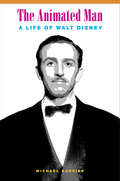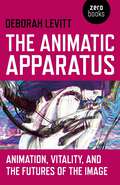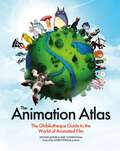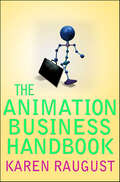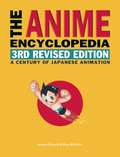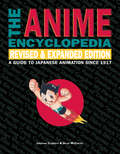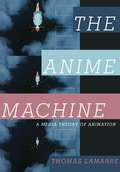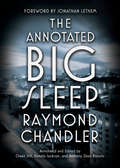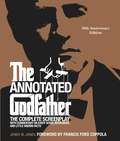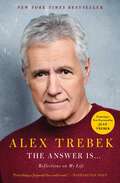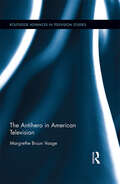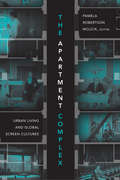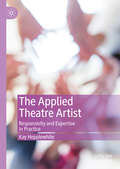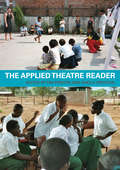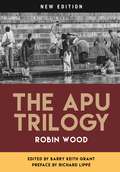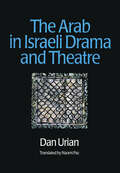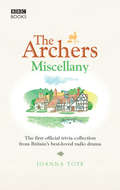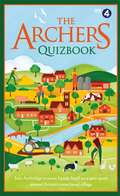- Table View
- List View
The Animated Man: A Life of Walt Disney
by Michael BarrierWalt Disney (1901-1966) was one of the most significant creative forces of the twentieth century, a man who made a lasting impact on the art of the animated film, the history of American business, and the evolution of twentieth-century American culture. He was both a creative visionary and a dynamic entrepreneur, roles whose demands he often could not reconcile. In his compelling new biography, noted animation historian Michael Barrier avoids the well-traveled paths of previous biographers, who have tended to portray a blemish-free Disney or to indulge in lurid speculation. Instead, he takes the full measure of the man in his many aspects. A consummate storyteller, Barrier describes how Disney transformed himself from Midwestern farm boy to scrambling young businessman to pioneering artist and, finally, to entrepreneur on a grand scale. Barrier describes in absorbing detail how Disney synchronized sound with animation in Steamboat Willie; created in Snow White and the Seven Dwarfs sympathetic cartoon characters whose appeal rivaled that of the best live-action performers; grasped television’s true potential as an unparalleled promotional device; and—not least—parlayed a backyard railroad into the Disneyland juggernaut. Based on decades of painstaking research in the Disney studio’s archives and dozens of public and private archives in the United States and Europe, The Animated Man offers freshly documented and illuminating accounts of Disney’s childhood and young adulthood in rural Missouri and Kansas City. It sheds new light on such crucial episodes in Disney’s life as the devastating 1941 strike at his studio, when his ambitions as artist and entrepreneur first came into serious conflict.Beginning in 1969, two and a half years after Disney’s death, Barrier recorded long interviews with more than 150 people who worked alongside Disney, some as early as 1922. Now almost all deceased, only a few were ever interviewed for other books. Barrier juxtaposes Disney’s own recollections against the memories of those other players to great effect. What emerges is a portrait of Walt Disney as a flawed but fascinating artist, one whose imaginative leaps allowed him to vault ahead of the competition and produce work that even today commands the attention of audiences worldwide.
The Animatic Apparatus: Animation, Vitality, and the Futures of the Image
by Deborah LevittUnprecedented kinds of experience, and new modes of life, are now produced by simulations, from the CGI of Hollywood blockbusters to animal cloning to increasingly sophisticated military training software, while animation has become an increasingly powerful pop-cultural form. Today, the extraordinary new practices and radical objects of simulation and animation are transforming our neoliberal-biopolitical &“culture of life&”. The Animatic Apparatus offers a genealogy for the animatic regime and imagines its alternative futures, countering the conservative-neoliberal notion of life&’s sacred inviolability with a new concept and ethics of animatic life.
The Animation Atlas: The Ghibliotheque Guide to the World of Animated Film
by Jake Cunningham Michael LeaderAnimation is a global artform, and The Animation Atlas is your essential guide to this exciting, expansive world.From Michael Leader and Jake Cunningham, authors and hosts of the Ghibliotheque podcast, comes this whistle-stop tour through animated film history. A cartography of cartoons, The Animation Atlas takes in everything from titans of animation such as Disney, Pixar, Aardman and Studio Ghibli to pioneers, innovators and rising stars from the wider world of cinema.A truly global history of animation - Each of the 30 chapters sets down in a different country to focus on local talent that has made a global impact on the form, from Spain to South Africa and China to Chile.Box office hits and hidden gems - Features a dazzling selection of films, from hand-drawn Hollywood classics (Snow White and the Seven Dwarfs) and award-winning CG masterpieces (Flow), to the works of revered artists such as Lotte Reiniger (The Adventures of Prince Achmed), Jan Švankmajer (Alice) and Hayao Miyazaki (My Neighbour Totoro).Dozens of gorgeous illustrations - Includes more than 150 photographs, artworks and stills from some of the most beautiful animated films ever made. A perfect gift for film lovers.
The Animation Atlas: The Ghibliotheque Guide to the World of Animated Film
by Jake Cunningham Michael LeaderAnimation is a global artform, and The Animation Atlas is your essential guide to this exciting, expansive world.From Michael Leader and Jake Cunningham, authors and hosts of the Ghibliotheque podcast, comes this whistle-stop tour through animated film history. A cartography of cartoons, The Animation Atlas takes in everything from titans of animation such as Disney, Pixar, Aardman and Studio Ghibli to pioneers, innovators and rising stars from the wider world of cinema.A truly global history of animation - Each of the 30 chapters sets down in a different country to focus on local talent that has made a global impact on the form, from Spain to South Africa and China to Chile.Box office hits and hidden gems - Features a dazzling selection of films, from hand-drawn Hollywood classics (Snow White and the Seven Dwarfs) and award-winning CG masterpieces (Flow), to the works of revered artists such as Lotte Reiniger (The Adventures of Prince Achmed), Jan Švankmajer (Alice) and Hayao Miyazaki (My Neighbour Totoro).Dozens of gorgeous illustrations - Includes more than 150 photographs, artworks and stills from some of the most beautiful animated films ever made. A perfect gift for film lovers.
The Animation Business Handbook
by Karen RaugustToday, animation is more prevalent than ever in television, films, video games, and the Internet. Karen Raugust has created a much needed, comprehensive look at the entire business. She shows in detail how a successful animation studio or entrepreneur operates, describes the process of developing an animation property from the concept stage through the finished product, and outlines business methods used to create and sell animated media.Topics covered include:* Distribution, sales, and marketing methods* Financing, budgeting, costs and revenue opportunities* The creation of ancillary entertainment and merchandise* Animation in international markets.The Animation Business Handbook is the quintessential reference for anyone in or considering entering the animation industry.
The Animation Smears Book: Uncovering Film's Most Elusive Technique
by Christian AvenderThroughout cinema, there have been various techniques to depict motion, and one style in particular is the fascinating use of smears in animation. Incredibly popular and captivating to artists, these animation smears are frames that creatively replicate motion blur captured on film, which is the phenomena that we commonly observe in our everyday life.The vast world of different techniques for smears is explored in this book, expanding way beyond their commonly believed starting point in the 1940s to their actual origins that date back to the beginning of art history with illustrations and prototypes that led to their usage in some of the earliest known theatrical animations.The Animation Smears Book: Uncovering Film’s Most Elusive Technique is a comprehensive guide that provides extensive information on the stylistic and creative aspects of smears and their impact, on how they make use of the way we perceive motion. Additionally, this book also reveals the names of artists who helped develop smears and the original techniques that were used.Thoroughly examined by a professional animator, the animation smear is highlighted as a versatile technique used in all forms of animation including 3D and stop‑motion. This book answers all of the questions that readers ever had about smears and brings clarity to this simple yet mysterious trick that has puzzled fans, scholars, and historians for centuries.
The Anime Ecology: A Genealogy of Television, Animation, and Game Media
by Thomas LamarreA major work destined to change how scholars and students look at television and animation With the release of author Thomas Lamarre&’s field-defining study The Anime Machine, critics established Lamarre as a leading voice in the field of Japanese animation. He now returns with The Anime Ecology, broadening his insights to give a complete account of anime&’s relationship to television while placing it within important historical and global frameworks. Lamarre takes advantage of the overlaps between television, anime, and new media—from console games and video to iOS games and streaming—to show how animation helps us think through television in the contemporary moment. He offers remarkable close readings of individual anime while demonstrating how infrastructures and platforms have transformed anime into emergent media (such as social media and transmedia) and launched it worldwide. Thoughtful, thorough illustrations plus exhaustive research and an impressive scope make The Anime Ecology at once an essential reference book, a valuable resource for scholars, and a foundational textbook for students.
The Anime Encyclopedia, 3rd Revised Edition
by Jonathan Clements Helen Mccarthy"Impressive, exhaustive, labyrinthine, and obsessive--The Anime Encyclopedia is an astonishing piece of work."--Neil GaimanOver one thousand new entries . . . over four thousand updates . . . over one million words. . .This third edition of the landmark reference work has six additional years of information on Japanese animation, its practitioners and products, plus incisive thematic entries on anime history and culture. With credits, links, cross-references, and content advisories for parents and libraries.Watch for the e-book edition in December 2014, ISBN 9781611729092, $24.95Jonathan Clements has been an editor of Manga Max and a contributing editor of Newtype USA.Helen McCarthy was founding editor of Anime UK and editor of Manga Mania.
The Anime Encyclopedia, Revised & Expanded Edition
by Jonathan Clements Helen MccarthyBigger and better! Our first edition rocked the anime world with its in-depth entries on anime famous and obscure and its superb index/film finder. Now this fantastic book is 40 percent larger--with all-new entries on hundreds of anime released after 2001, updates on older entries, and over fifty thousand words on anime creators (like Tezuka and Otomo) and genres ("Early Anime," "Science Fiction and Robots," etc.). An absolute must-have for every anime shelf!"If I only had space on my overcrowded shelf for one book on anime, this would be it. If I had no space on my shelf I'd select two books at random and drop them into the bin, just to make room-- it's that indispensable."-- Paul Jacques, Anime on DVD"While you may not agree with their opinons on a given anime, they are informative and entertaining, especially when skewering a really bad anime." -- Frames Per Second
The Anime Machine: A Media Theory of Animation
by Thomas LamarreDespite the longevity of animation and its significance within the history of cinema, film theorists have focused on live-action motion pictures and largely ignored hand-drawn and computer-generated movies. Thomas Lamarre contends that the history, techniques, and complex visual language of animation, particularly Japanese animation, demands serious and sustained engagement, and in The Anime Machine he lays the foundation for a new critical theory for reading Japanese animation, showing how anime fundamentally differs from other visual media.The Anime Machine defines the visual characteristics of anime and the meanings generated by those specifically &“animetic&” effects—the multiplanar image, the distributive field of vision, exploded projection, modulation, and other techniques of character animation—through close analysis of major films and television series, studios, animators, and directors, as well as Japanese theories of animation. Lamarre first addresses the technology of anime: the cells on which the images are drawn, the animation stand at which the animator works, the layers of drawings in a frame, the techniques of drawing and blurring lines, how characters are made to move. He then examines foundational works of anime, including the films and television series of Miyazaki Hayao and Anno Hideaki, the multimedia art of Murakami Takashi, and CLAMP&’s manga and anime adaptations, to illuminate the profound connections between animators, characters, spectators, and technology.Working at the intersection of the philosophy of technology and the history of thought, Lamarre explores how anime and its related media entail material orientations and demonstrates concretely how the &“animetic machine&” encourages a specific approach to thinking about technology and opens new ways for understanding our place in the technologized world around us.
The Animist Imagination in East Asian Cinema (Critical Asian Cinemas)
by Pao-chen TangWhispering winds, speeding trains, wandering balloons, and swirling snowflakes—these are the living entities that humans find themselves enmeshed with in their ecological co-flourishing in contemporary East Asian cinema. Pao-chen Tang theorizes and analyzes this animist imagination—a new mode of filmmaking that delves into both the definition of the cinematic medium and how to live with the nonhuman. Moving images are animate beings and the animism of cinema further compels an eye-opening vision to examine East Asian history and ecological anxieties of our times. The shamanic protagonists of the animist imagination transform the worldly and medial figurations onscreen into thought experiments on human-nonhuman relationality, modelling for the viewers anti-anthropocentric forms of existence and action. The book distills this form of agency through a systematic analysis of narrative structures, stylistic devices, and cultural implications in a stunning demonstration of a world viewed and enacted otherwise.
The Annotated Big Sleep
by Raymond ChandlerThe first fully annotated edition of Raymond Chandler&’s 1939 classic The Big Sleep features hundreds of illuminating notes and images alongside the full text of the novel and is an essential addition to any crime fiction fan&’s library. A masterpiece of noir, Raymond Chandler's The Big Sleep helped to define a genre. Today it remains one of the most celebrated and stylish novels of the twentieth century. This comprehensive, annotated edition offers a fascinating look behind the scenes of the novel, bringing the gritty and seductive world of Chandler's iconic private eye Philip Marlowe to life. The Annotated Big Sleep solidifies the novel&’s position as one of the great works of American fiction and will surprise and enthrall Chandler&’s biggest fans. Including: -Personal letters and source texts -The historical context of Chandler&’s Los Angeles, including maps and images -Film stills and art from the early pulps -An analysis of class, gender, sexuality, and ethnicity in the novel
The Annotated Godfather: 50th Anniversary Edition with the Complete Screenplay, Commentary on Every Scene, Interviews, and Little-Known Facts
by Jenny M. JonesCelebrating the 50th anniversary of The Godfather, this authorized, annotated and illustrated edition of the complete, unedited screenplay includes all the little-known facts, behind-the-scenes intrigue, and first-person reflections from cast and crew members on the making of this landmark film.From its ingenious cinematic innovations and memorable, oft-quoted script to its iconic cast, including Marlon Brando, Al Pacino, Robert Duvall, James Caan, The Godfather is considered by many to be the greatest movie ever made. And yet, the history of its making is so colorful, so chaotic, that one cannot help but marvel at the seemingly insurmountable odds it overcame to become a true cinematic masterpiece, and a film that continues to captivate its audience decades after its release.In this authorized, annotated, and illustrated edition of the complete screenplay, nearly every scene is examined and dissected, including: Fascinating commentary on technical details about the filming and shooting locationsTales from the set, including arguments, accidents, anecdotes and practical jokesProfiles of the actors and stories of how they were castDeleted scenes that never made the final cut, and the goofs and gaffes that didAnd much more!Interviews with former Paramount executives, cast and crew members, and director Francis Ford Coppola, round out the commentary and shed new light on everything you thought you knew about this most influential film. With more than 200 photographs, this a truly unique, collectable keepsake for every Godfather fan.
The Answer Is . . .: Reflections on My Life
by Alex TrebekLongtime Jeopardy! host and television icon Alex Trebek reflects on his life and career.When he debuted as the host of Jeopardy! in 1984, Alex Trebek became something like a family member to millions of television viewers, bringing entertainment and education into their homes five nights a week. In 2019, he made the stunning announcement that he had been diagnosed with Stage IV pancreatic cancer. What followed was an incredible outpouring of love and kindness. Social media was flooded with messages of support, and the Jeopardy! studio received boxes of cards and letters offering guidance, encouragement, and prayers. For more than three decades, Trebek had resisted countless appeals to write a book about his life. Yet he was moved so much by all the goodwill, he felt compelled to finally share his story. &“I want people to know a little more about the person they have been cheering on for the past year,&” he writes. The book combines illuminating personal anecdotes with Trebek&’s thoughts on a range of topics, including marriage, parenthood, education, success, spirituality, and philanthropy. Trebek also addresses the questions asked most often by Jeopardy! fans, such as what prompted him to shave his signature mustache, his insights on legendary players like Ken Jennings and James Holzhauer, and his opinion of Will Ferrell&’s Saturday Night Live impersonation. The book uses a novel structure inspired by Jeopardy! and features dozens of never-before-seen photos that candidly capture Trebek over the years. This wise, charming, and inspiring book is further evidence of why Trebek has long been considered one of the most beloved and respected figures in entertainment.
The Antihero in American Television (Routledge Advances in Television Studies)
by Margrethe Bruun VaageThe antihero prevails in recent American drama television series. Characters such as mobster kingpin Tony Soprano (The Sopranos), meth cook and gangster-in-the-making Walter White (Breaking Bad) and serial killer Dexter Morgan (Dexter) are not morally good, so how do these television series make us engage in these morally bad main characters? And what does this tell us about our moral psychological make-up, and more specifically, about the moral psychology of fiction? Vaage argues that the fictional status of these series deactivates rational, deliberate moral evaluation, making the spectator rely on moral emotions and intuitions that are relatively easy to manipulate with narrative strategies. Nevertheless, she also argues that these series regularly encourage reactivation of deliberate, moral evaluation. In so doing, these fictional series can teach us something about ourselves as moral beings—what our moral intuitions and emotions are, and how these might differ from deliberate, moral evaluation.
The Apartment Complex: Urban Living and Global Screen Cultures
by Pamela Robertson WojcikFrom the bachelor pad that Jack Lemmon's C. C. Baxter loans out to his superiors in Billy Wilder's The Apartment (1960) to the crumbling tenement in a dystopian Taipei in Tsai Ming-liang's The Hole (1998), the apartment in films and television series is often more than just a setting: it can motivate or shape the narrative in key ways. Such works belong to a critical genre identified by Pamela Robertson Wojcik as the apartment plot, which comprises specific thematic, visual, and narrative conventions that explore modern urbanism's various forms and possibilities. In The Apartment Complex a diverse group of international scholars discuss the apartment plot in a global context, examining films made both within and beyond the Hollywood studios. The contributors consider the apartment plot's intersections with film noir, horror, comedy, and the musical, addressing how different national or historical contexts modify the apartment plot and how the genre's framework allows us to rethink the work of auteurs and identify productive connections and tensions between otherwise disparate texts. Contributors. Steven Cohan, Michael DeAngelis, Veronica Fitzpatrick, Annamarie Jagose, Paula J. Massood, Joe McElhaney, Merrill Schleier, Lee Wallace, Pamela Robertson Wojcik
The Apartment Plot: Urban Living in American Film and Popular Culture, 1945 to 1975
by Pamela Robertson WojcikRethinking the significance of films including Pillow Talk, Rear Window, and The Seven Year Itch, Pamela Robertson Wojcik examines the popularity of the "apartment plot," her term for stories in which the apartment functions as a central narrative device. From the baby boom years into the 1970s, the apartment plot was not only key to films; it also surfaced in TV shows, Broadway plays, literature, and comic strips, from The Honeymooners and The Mary Tyler Moore Show to Subways are for Sleeping and Apartment 3-G. By identifying the apartment plot as a film genre, Wojcik reveals affinities between movies generally viewed as belonging to such distinct genres as film noir, romantic comedy, and melodrama. She analyzes the apartment plot as part of a mid-twentieth-century urban discourse, showing how it offers a vision of home centered on values of community, visibility, contact, mobility, impermanence, and porousness that contrasts with views of home as private, stable, and family-based. Wojcik suggests that the apartment plot presents a philosophy of urbanism related to the theories of Jane Jacobs and Henri Lefebvre. Urban apartments were important spaces for negotiating gender, sexuality, race, and class in mid-twentieth-century America.
The Applied Theatre Artist: Responsivity and Expertise in Practice
by Kay HepplewhiteThis book analyses the work of applied theatre practitioners using a new framework of ‘responsivity’ to make visible their unique expertise. In-depth investigation of practice combines with theorisation to provide a fresh view of the work of artists and facilitators. Case studies are drawn from community contexts: with women, mental health service users, refugees, adults with a learning disability, older people in care, and young people in school. Common skills and qualities are given a vocabulary to help define applied theatre work, such as awareness, anticipation, adaptation, attunement, and responsiveness. The Applied Theatre Artist is of scholarly, practical, and educational interest. The book offers detailed analysis of how skilled theatre artists make in-action decisions within socially engaged participatory projects. Rich description of in-session activity reveals what workshop facilitators actually do and how they think, offering a rare focus in applied theatre.
The Applied Theatre Reader
by Tim Prentki Sheila PrestonThe Applied Theatre Reader is the first book to bring together new case studies of practice by leading practitioners and academics in the field and beyond, with classic source texts from writers such as Noam Chomsky, bell hooks, Mikhail Bakhtin, Augusto Boal, and Chantal Mouffe. This book divides the field into key themes, inviting critical interrogation of issues in applied theatre whilst also acknowledging the multi-disciplinary nature of its subject. It crosses fields such as: theatre in educational settings prison theatre community performance theatre in conflict resolution and reconciliation interventionist theatre theatre for development. This collection of critical thought and practice is essential to those studying or participating in the performing arts as a means for positive change.
The Apu Trilogy: New Edition (Contemporary Approaches to Film and Media Series)
by Robin WoodThe Apu Trilogy is the fifth book written by influential film critic Robin Wood and republished for a contemporary audience. Focusing on the famed trilogy from Indian director Satyajit Ray, Wood persuasively demonstrates his ability at detailed textual analysis, providing an impressively sustained reading that elucidates the complex view of life in the trilogy. Wood was one of our most insightful and committed film critics, championing films that explore the human condition. His analysis of The Apu Trilogy reveals and illuminates the films' profoundly humanistic qualities with clarity and rigor, plumbing the psychological and emotional resonances that arise from Ray's delicate balance of performance, camerawork, and visual design. Wood was the first English-language critic to write substantively about Ray's films, which made the original publication of his monograph on The Apu Trilogy unprecedented as well as impressive. Of late there has been a renewed interest in North America in the work of Satyajit Ray, yet no other critic has come close to equaling the scope and depth of his analysis. In his introduction, originally published in 1971, Wood says reactions to Ray's work were met with indifference. In response, he offers possible reasons why this occurred, including social and cultural differences and the films' slow pacing, which contemporary critics tended to associate with classical cinema. Wood notes Ray's admiration for Western film culture, including the Hollywood cinema and European directors, particularly Jean Renoir and his realist films. Assigning a chapter to each Pather Panchali (1955), Aparajito, (1957), and The World of Apu, (1959), Wood goes on to explore each film more thoroughly. One of the aspects of this book that is particularly rewarding is Wood's analytical approach to the trilogy as a whole, as well as detailed attention given to each of the three films. The book, with a new preface by Richard Lippe and foreword by Barry Keith Grant, functions as a master class on what constitutes an in-depth reading of a work and the use of critical tools that are relevant to such a task. Robin Wood's The Apu Trilogy offers an excellent account of evaluative criticism that will appeal to film scholars and students alike.
The Arab in Israeli Drama and Theatre (Contemporary Theatre Studies #Vol. 26)
by Dan UrianWhat is Israeli theatre? Is it only a Hebrew theatre staged in Israel? Are performances by Arab Israelis working in an Arabic theatre framework not part of the repertoire of Israeli theatre? Do they perhaps belong to the Palestinian theatre? What are the "borders" of Palestinian theatre? Are not theatrical works created in East Jerusalem by Arab Israeli playwrights and actors, and staged on occasion before Jewish Israeli audiences, part of a dialogue between Palestinian and Israeli cultures? Does "theatre" only include works staged under that title? These and other similarly absorbing questions arise in Dan Urian's wide-ranging and detailed study of the image of the Arab in Israeli drama and theatre. By the use of extensive examples to show how theatre, politics and personal perceptions intertwine, the author presents us with a model which can be used as a basis for the further discussion and study of similar social and artistic phenomena in other cultures in relation to their theatre and drama.
The Archers Archives
by Simon Frith Chris ArnotThe Archers Archives celebrates 60 years of the nation's favourite radio drama - looking back at the most dramatic events to happen over 16,000 episodes, complete with cast and crew interviews. Relive the defining moments in Archers history, from the devastating 1955 stables fire and the 1957 Tom Forrest manslaughter charge to the shocking imprisonment of Susan Carter in the early 1990s, the revelation of Brian Aldridge's affair with Siobhan Hathaway, and the Grundys' eviction from Grange Farm and exile to Meadow Rise.Script-writer Simon Frith and journalist Chris Arnot take you inside the creative life of the show, sharing how the series' storylines are planned and produced, and how the historical and cultural background of each period is interwoven into the everyday lives of the residents of Ambridge. Complete with original photos, some never-before-seen, The Archers Archives is an indispensable addition to every Archers fan's collection.
The Archers Miscellany
by Joanna ToyeThe first official trivia collection from Britain's best-loved radio drama.Have you ever wondered about the attractions at Ambridge fetes? Puzzled over who the winners were at the Flower and Produce Show? Been curious about details of past Bonfire Nights, or even menus at The Bull? Discover the whos, whats, wheres and whys of the show's past 60 years in The Archers Miscellany.Discover which resident has the most names and meet the animals of Ambridge; learn the order of illumination for the Christmas lights switch-on; ponder Great Ambridge Mysteries and remember Ambridge Wanderers football team fixtures from the glory days of the 1970s.Containing information gathered from the vast BBC Birmingham Archers archives and beautifully illustrated throughout, The Archers Miscellany is the ultimate trivia book for all things Ambridge.
The Archers Quizbook: Join Ambridge treasure Lynda Snell on a quiz quest around Britain's most loved village
by The Puzzle HouseWhich traditionally comes first in the Ambridge year, the Village Fete or the Flower and Produce Show?Which tool appears on the Pargetter coat of arms?Which member of the Archers clan has a first name where all the letters read in alphabetical order?Ambridge is a place many of us know almost as well as our own home towns. But while millions of people are invested in the goings-on in this picturesque village, few have had the privilege of walking its winding lanes. Now you can. Join Lynda Snell, a true pillar of this rural community, as she takes you on a guided tour of radio's most well-loved village.Starting at the summit of Lakey Hill, with its sweeping views of rural Borsetshire, Lynda will lead you around the village's landmarks and institutions imparting wisdom and gossip as she goes. Sun yourself in the beer garden of the Bull, watch the world go by from a bench on the village green and don your wellies for a wander around Brookfield. There are weddings to attend at St Stephen's, productions to enjoy at the Village Hall and deals to be done at the Dower House.Each chapter centres on key locations to challenge your knowledge in all manner of Ambridge affairs. Whether you're a lifelong listener of The Archers, have an ear for gossip, or are a relative newbie, you will be able to put your area of expertise to the test. With 70 years of rich rural history to explore, you might even learn something new.
The Archers Quizbook: Join Ambridge treasure Lynda Snell on a quiz quest around Britain's most loved village
by The Puzzle HouseWhich traditionally comes first in the Ambridge year, the Village Fete or the Flower and Produce Show?Which tool appears on the Pargetter coat of arms?Which member of the Archers clan has a first name where all the letters read in alphabetical order?Ambridge is a place many of us know almost as well as our own home towns. But while millions of people are invested in the goings-on in this picturesque village, few have had the privilege of walking its winding lanes. Now you can. Join Lynda Snell, a true pillar of this rural community, as she takes you on a guided tour of radio's most well-loved village.Starting at the summit of Lakey Hill, with its sweeping views of rural Borsetshire, Lynda will lead you around the village's landmarks and institutions imparting wisdom and gossip as she goes. Sun yourself in the beer garden of the Bull, watch the world go by from a bench on the village green and don your wellies for a wander around Brookfield. There are weddings to attend at St Stephen's, productions to enjoy at the Village Hall and deals to be done at the Dower House.Each chapter centres on key locations to challenge your knowledge in all manner of Ambridge affairs. Whether you're a lifelong listener of The Archers, have an ear for gossip, or are a relative newbie, you will be able to put your area of expertise to the test. With 70 years of rich rural history to explore, you might even learn something new.
